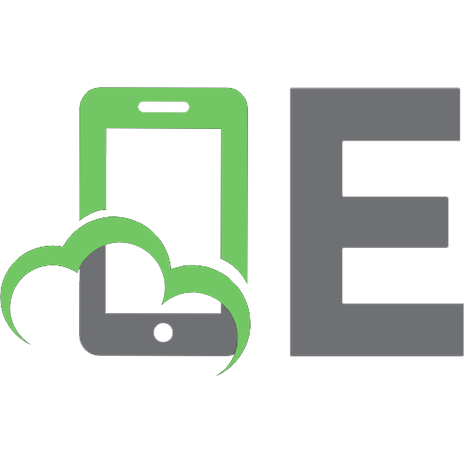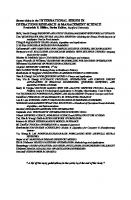Introduction to operations and supply chain management [4th ed] 9780133871777, 1292093420, 9781292093420, 0133871770
NOTE: MyOMLabdoes not come packaged with this content. If you would like to purchase both the physical text andMyOMLabse
413 26 3MB
English Pages XVI, 487 str.: ilustr.; 28 cm [504] Year 2015;2016
Table of contents :
Cover......Page 1
Title Page......Page 2
Copyright Page......Page 3
About the Authors......Page 5
Brief Contents......Page 6
Contents......Page 7
Preface......Page 12
1 Introduction to operations and supply Chain management......Page 18
Introduction......Page 19
1.1 Why Study Operations and Supply Chain Management?......Page 20
Operations Management......Page 21
Supply Chain Management......Page 23
1.2 Important Trends......Page 26
Relationship Management......Page 27
Professional Organizations......Page 28
Cross-Functional and Interorganizational Linkages......Page 29
1.4 Purpose and Organization of This Book......Page 30
Key Terms......Page 31
Case Study......Page 32
References......Page 33
2 Operations and supply Chain strategies......Page 35
2.2 Strategy......Page 37
2.3 Operations and Supply Chain Strategies......Page 40
Customer Value......Page 41
Four Performance Dimensions......Page 42
Order Winners and Order Qualifiers......Page 44
Stages of Alignment with the Business Strategy......Page 45
Core Competencies in Operations and Supply Chains......Page 46
Key Formula......Page 48
Solved Problem......Page 49
Discussion Questions......Page 50
Problems......Page 51
Case Study......Page 52
References......Page 53
3 Process Choice and layout decisions in manufacturing and services......Page 54
Introduction......Page 55
3.1 Manufacturing Processes......Page 56
Production Lines and Continuous Flow Manufacturing......Page 57
Job Shops......Page 58
Hybrid Manufacturing Processes......Page 59
Linking Manufacturing Processes across the Supply Chain......Page 60
3.2 Product Customization within the Supply Chain......Page 61
The Customization Point......Page 62
3.3 Service Processes......Page 64
Service Packages......Page 65
Service Customization......Page 66
Customer Contact......Page 67
Service Positioning......Page 70
Services within the Supply Chain......Page 71
Line Balancing......Page 72
Assigning Department Locations in Functional Layouts......Page 76
Chapter Summary......Page 79
Solved Problem......Page 80
Problems......Page 83
Case Study......Page 86
References......Page 87
4 Business Processes......Page 88
Introduction......Page 89
Improving Business Processes......Page 90
Process Maps......Page 93
Swim Lane Process Maps......Page 96
Productivity......Page 98
Efficiency......Page 100
Cycle Time......Page 101
Benchmarking......Page 102
The Six Sigma Methodology......Page 103
Continuous Improvement Tools......Page 104
How Standardized Should Processes Be?......Page 112
The SCOR Model......Page 113
Key Formulas......Page 115
Solved Problem......Page 116
Problems......Page 118
Case Study......Page 120
References......Page 121
5 Managing Quality......Page 122
5.1 Quality Defined......Page 124
5.2 Total Cost of Quality......Page 127
5.3 Total Quality Management......Page 129
TQM and the Six Sigma Methodology......Page 131
Process Capability......Page 132
Six Sigma Quality......Page 134
Control Charts......Page 135
Acceptance Sampling......Page 141
Taguchi’s Quality Loss Function......Page 143
ISO 9000 Family......Page 144
Key Formulas......Page 145
Key Terms......Page 147
Solved Problem......Page 148
Discussion Questions......Page 149
Problems......Page 150
Case Study......Page 154
References......Page 155
6 Managing Capacity......Page 156
6.1 Capacity......Page 157
Measures of Capacity......Page 158
6.2 Three Common Capacity Strategies......Page 159
Cost......Page 161
Expected Value......Page 164
Decision Trees......Page 165
Break-Even Analysis......Page 167
Learning Curves......Page 168
Other Considerations......Page 171
The Theory of Constraints......Page 172
Waiting Line Theory......Page 175
Little’s Law......Page 179
Key Formulas......Page 181
Using Excel in Capacity Management......Page 183
Solved Problem......Page 184
Problems......Page 185
References......Page 189
6s Advanced Waiting line theory and simulation modeling......Page 190
6S.1 Alternative Waiting Lines......Page 191
Waiting Line Formulas for Three Different Environments......Page 192
6S.1 Simulation Modeling......Page 196
Monte Carlo Simulation......Page 197
Building and Evaluating Simulation Models with SimQuick......Page 199
Supplement Summary......Page 202
References......Page 203
7 Supply management......Page 204
Introduction......Page 205
Financial Impact......Page 206
Performance Impact......Page 209
Step 1: Assess Opportunities......Page 210
Step 2: Profile Internally and Externally......Page 211
Step 3: Develop the Sourcing Strategy......Page 214
Step 4: Screen Suppliers and Create Selection Criteria......Page 220
Step 5: Conduct Supplier Selection......Page 221
Step 6: Negotiate and Implement Agreements......Page 223
Receipt and Inspection......Page 225
Sustainable Supply......Page 226
Supply Chain Disruptions......Page 227
Key Terms......Page 228
Solved Problem......Page 229
Problems......Page 230
Case Study......Page 232
References......Page 233
8 Logistics......Page 234
8.1 Why Logistics is Critical......Page 236
Transportation......Page 237
Selecting a Transportation Mode......Page 238
Multimodal Solutions......Page 239
Warehousing......Page 240
Logistics Information Systems......Page 243
Material Handling and Packaging......Page 245
Owning versus Outsourcing......Page 246
Measuring Logistics Performance......Page 248
Landed Costs......Page 249
Reverse Logistics Systems......Page 250
Weighted Center of Gravity Method......Page 251
The Assignment Problem......Page 253
Chapter Summary......Page 258
Key Terms......Page 259
Solved Problem......Page 260
Problems......Page 261
Case Study......Page 264
References......Page 265
9 Forecasting......Page 266
Introduction......Page 267
Price Forecasts......Page 268
9.2 Laws of Forecasting......Page 269
9.3 Selecting a Forecasting Method......Page 270
9.4 Qualitative Forecasting Methods......Page 271
9.5 Time Series Forecasting Models......Page 272
Last Period......Page 273
Moving Average......Page 274
Exponential Smoothing......Page 276
Adjusted Exponential Smoothing......Page 279
Linear Regression......Page 280
Seasonal Adjustments......Page 284
Linear Regression......Page 288
Multiple Regression......Page 290
9.7 Measures of Forecast Accuracy......Page 293
9.9 Collaborative Planning, Forecasting, and Replenishment (CPFR)......Page 295
Key Formulas......Page 300
Solved Problem......Page 302
Problems......Page 305
Case Study......Page 309
References......Page 310
10 Sales and operations Planning (aggregate Planning)......Page 311
10.1 S&OP in the Planning Cycle......Page 312
10.2 Major Approaches to S&OP......Page 314
Top-Down Planning......Page 315
Level, Chase, and Mixed Production Plans......Page 317
Bottom-Up Planning......Page 321
Cash Flow Analysis......Page 323
Choosing between Alternative Plans......Page 325
Rolling Planning Horizons......Page 326
Implementing S&OP in an Organization......Page 327
Making Sales Match Capacity......Page 328
Making Capacity Match Sales......Page 329
10.5 Linking S&OP throughout the Supply Chain......Page 330
10.6 Applying Optimization Modeling to S&OP......Page 331
Key Formulas......Page 334
Solved Problem......Page 335
Problems......Page 336
Case Study......Page 341
References......Page 342
11 Managing inventory throughout the supply Chain......Page 343
Introduction......Page 345
Inventory Types......Page 346
Inventory Drivers......Page 348
11.2 Periodic Review Systems......Page 350
Restocking Levels......Page 351
11.3 Continuous Review Systems......Page 352
The Economic Order Quantity (EOQ)......Page 353
Reorder Points and Safety Stock......Page 355
Quantity Discounts......Page 357
11.4 Single-Period Inventory Systems......Page 359
Target Service Level......Page 360
Target Stocking Point......Page 361
The Bullwhip Effect......Page 363
Inventory Positioning......Page 364
Transportation, Packaging, and Material Handling Considerations......Page 365
Chapter Summary......Page 366
Key Formulas......Page 367
Using Excel in Inventory Management......Page 368
Discussion Questions......Page 369
Problems......Page 370
Case Study......Page 373
References......Page 374
12 Managing Production across the supply Chain......Page 375
Introduction......Page 376
12.1 Master Scheduling......Page 377
The Master Schedule Record......Page 378
Using the Master Schedule......Page 383
12.2 Material Requirements Planning......Page 384
The MRP Record......Page 386
Special Considerations in MRP......Page 391
Job Sequencing......Page 393
Monitoring and Tracking Technologies......Page 394
Distribution Requirements Planning......Page 395
Chapter Summary......Page 398
Key Terms......Page 400
Discussion Questions......Page 401
Problems......Page 402
References......Page 409
12s Supply Chain information systems......Page 410
Differences across Organizational Levels......Page 411
12S.2 Supply Chain Information Systems......Page 413
12S.3 Trends to Watch......Page 415
Cloud Computing......Page 416
Discussion Questions......Page 417
References......Page 418
13 Jit/Lean Production......Page 419
Introduction......Page 421
13.1 The Lean Perspective on Waste......Page 422
13.2 The Lean Perspective on Inventory......Page 423
13.3 Recent Developments in Lean Thinking......Page 424
13.4 Kanban Systems......Page 425
Controlling Inventory Levels Using Kanbans......Page 430
Synchronizing the Supply Chain Using Kanbans......Page 432
Using MRP and Kanban Together......Page 433
Key Formula......Page 434
Solved Problem......Page 435
Problems......Page 436
Case Study......Page 437
References......Page 439
14 Managing Projects......Page 440
Introduction......Page 441
14.1 The Growing Importance of Project Management......Page 442
Project Definition Phase......Page 443
Postcompletion Phase......Page 444
Gantt Charts......Page 445
Constructing a Network Diagram......Page 447
Crashing a Project......Page 451
14.4 Project Management Software......Page 453
Key Formulas......Page 456
Solved Problem......Page 457
Discussion Questions......Page 458
Problems......Page 459
References......Page 461
15 Developing Products and services......Page 462
Four Reasons for Developing New Products and Services......Page 464
15.1 Operations and Supply Chain Perspectives on Design......Page 465
Production Volumes......Page 466
Match with Existing Capabilities......Page 467
A Model of the Development Process......Page 468
15.3 Organizational Roles in Product and Service Development......Page 470
Designers......Page 471
Suppliers......Page 472
DMADV (Define–Measure–Analyze– Design–Verify)......Page 473
Quality Function Deployment (QFD)......Page 474
The “Design for …” Approaches......Page 475
Target Costing and Value Analysis......Page 476
Key Terms......Page 477
Case Study......Page 478
References......Page 479
Appendices......Page 480
Glossary......Page 486
Index......Page 498
Cover......Page 1
Title Page......Page 2
Copyright Page......Page 3
About the Authors......Page 5
Brief Contents......Page 6
Contents......Page 7
Preface......Page 12
1 Introduction to operations and supply Chain management......Page 18
Introduction......Page 19
1.1 Why Study Operations and Supply Chain Management?......Page 20
Operations Management......Page 21
Supply Chain Management......Page 23
1.2 Important Trends......Page 26
Relationship Management......Page 27
Professional Organizations......Page 28
Cross-Functional and Interorganizational Linkages......Page 29
1.4 Purpose and Organization of This Book......Page 30
Key Terms......Page 31
Case Study......Page 32
References......Page 33
2 Operations and supply Chain strategies......Page 35
2.2 Strategy......Page 37
2.3 Operations and Supply Chain Strategies......Page 40
Customer Value......Page 41
Four Performance Dimensions......Page 42
Order Winners and Order Qualifiers......Page 44
Stages of Alignment with the Business Strategy......Page 45
Core Competencies in Operations and Supply Chains......Page 46
Key Formula......Page 48
Solved Problem......Page 49
Discussion Questions......Page 50
Problems......Page 51
Case Study......Page 52
References......Page 53
3 Process Choice and layout decisions in manufacturing and services......Page 54
Introduction......Page 55
3.1 Manufacturing Processes......Page 56
Production Lines and Continuous Flow Manufacturing......Page 57
Job Shops......Page 58
Hybrid Manufacturing Processes......Page 59
Linking Manufacturing Processes across the Supply Chain......Page 60
3.2 Product Customization within the Supply Chain......Page 61
The Customization Point......Page 62
3.3 Service Processes......Page 64
Service Packages......Page 65
Service Customization......Page 66
Customer Contact......Page 67
Service Positioning......Page 70
Services within the Supply Chain......Page 71
Line Balancing......Page 72
Assigning Department Locations in Functional Layouts......Page 76
Chapter Summary......Page 79
Solved Problem......Page 80
Problems......Page 83
Case Study......Page 86
References......Page 87
4 Business Processes......Page 88
Introduction......Page 89
Improving Business Processes......Page 90
Process Maps......Page 93
Swim Lane Process Maps......Page 96
Productivity......Page 98
Efficiency......Page 100
Cycle Time......Page 101
Benchmarking......Page 102
The Six Sigma Methodology......Page 103
Continuous Improvement Tools......Page 104
How Standardized Should Processes Be?......Page 112
The SCOR Model......Page 113
Key Formulas......Page 115
Solved Problem......Page 116
Problems......Page 118
Case Study......Page 120
References......Page 121
5 Managing Quality......Page 122
5.1 Quality Defined......Page 124
5.2 Total Cost of Quality......Page 127
5.3 Total Quality Management......Page 129
TQM and the Six Sigma Methodology......Page 131
Process Capability......Page 132
Six Sigma Quality......Page 134
Control Charts......Page 135
Acceptance Sampling......Page 141
Taguchi’s Quality Loss Function......Page 143
ISO 9000 Family......Page 144
Key Formulas......Page 145
Key Terms......Page 147
Solved Problem......Page 148
Discussion Questions......Page 149
Problems......Page 150
Case Study......Page 154
References......Page 155
6 Managing Capacity......Page 156
6.1 Capacity......Page 157
Measures of Capacity......Page 158
6.2 Three Common Capacity Strategies......Page 159
Cost......Page 161
Expected Value......Page 164
Decision Trees......Page 165
Break-Even Analysis......Page 167
Learning Curves......Page 168
Other Considerations......Page 171
The Theory of Constraints......Page 172
Waiting Line Theory......Page 175
Little’s Law......Page 179
Key Formulas......Page 181
Using Excel in Capacity Management......Page 183
Solved Problem......Page 184
Problems......Page 185
References......Page 189
6s Advanced Waiting line theory and simulation modeling......Page 190
6S.1 Alternative Waiting Lines......Page 191
Waiting Line Formulas for Three Different Environments......Page 192
6S.1 Simulation Modeling......Page 196
Monte Carlo Simulation......Page 197
Building and Evaluating Simulation Models with SimQuick......Page 199
Supplement Summary......Page 202
References......Page 203
7 Supply management......Page 204
Introduction......Page 205
Financial Impact......Page 206
Performance Impact......Page 209
Step 1: Assess Opportunities......Page 210
Step 2: Profile Internally and Externally......Page 211
Step 3: Develop the Sourcing Strategy......Page 214
Step 4: Screen Suppliers and Create Selection Criteria......Page 220
Step 5: Conduct Supplier Selection......Page 221
Step 6: Negotiate and Implement Agreements......Page 223
Receipt and Inspection......Page 225
Sustainable Supply......Page 226
Supply Chain Disruptions......Page 227
Key Terms......Page 228
Solved Problem......Page 229
Problems......Page 230
Case Study......Page 232
References......Page 233
8 Logistics......Page 234
8.1 Why Logistics is Critical......Page 236
Transportation......Page 237
Selecting a Transportation Mode......Page 238
Multimodal Solutions......Page 239
Warehousing......Page 240
Logistics Information Systems......Page 243
Material Handling and Packaging......Page 245
Owning versus Outsourcing......Page 246
Measuring Logistics Performance......Page 248
Landed Costs......Page 249
Reverse Logistics Systems......Page 250
Weighted Center of Gravity Method......Page 251
The Assignment Problem......Page 253
Chapter Summary......Page 258
Key Terms......Page 259
Solved Problem......Page 260
Problems......Page 261
Case Study......Page 264
References......Page 265
9 Forecasting......Page 266
Introduction......Page 267
Price Forecasts......Page 268
9.2 Laws of Forecasting......Page 269
9.3 Selecting a Forecasting Method......Page 270
9.4 Qualitative Forecasting Methods......Page 271
9.5 Time Series Forecasting Models......Page 272
Last Period......Page 273
Moving Average......Page 274
Exponential Smoothing......Page 276
Adjusted Exponential Smoothing......Page 279
Linear Regression......Page 280
Seasonal Adjustments......Page 284
Linear Regression......Page 288
Multiple Regression......Page 290
9.7 Measures of Forecast Accuracy......Page 293
9.9 Collaborative Planning, Forecasting, and Replenishment (CPFR)......Page 295
Key Formulas......Page 300
Solved Problem......Page 302
Problems......Page 305
Case Study......Page 309
References......Page 310
10 Sales and operations Planning (aggregate Planning)......Page 311
10.1 S&OP in the Planning Cycle......Page 312
10.2 Major Approaches to S&OP......Page 314
Top-Down Planning......Page 315
Level, Chase, and Mixed Production Plans......Page 317
Bottom-Up Planning......Page 321
Cash Flow Analysis......Page 323
Choosing between Alternative Plans......Page 325
Rolling Planning Horizons......Page 326
Implementing S&OP in an Organization......Page 327
Making Sales Match Capacity......Page 328
Making Capacity Match Sales......Page 329
10.5 Linking S&OP throughout the Supply Chain......Page 330
10.6 Applying Optimization Modeling to S&OP......Page 331
Key Formulas......Page 334
Solved Problem......Page 335
Problems......Page 336
Case Study......Page 341
References......Page 342
11 Managing inventory throughout the supply Chain......Page 343
Introduction......Page 345
Inventory Types......Page 346
Inventory Drivers......Page 348
11.2 Periodic Review Systems......Page 350
Restocking Levels......Page 351
11.3 Continuous Review Systems......Page 352
The Economic Order Quantity (EOQ)......Page 353
Reorder Points and Safety Stock......Page 355
Quantity Discounts......Page 357
11.4 Single-Period Inventory Systems......Page 359
Target Service Level......Page 360
Target Stocking Point......Page 361
The Bullwhip Effect......Page 363
Inventory Positioning......Page 364
Transportation, Packaging, and Material Handling Considerations......Page 365
Chapter Summary......Page 366
Key Formulas......Page 367
Using Excel in Inventory Management......Page 368
Discussion Questions......Page 369
Problems......Page 370
Case Study......Page 373
References......Page 374
12 Managing Production across the supply Chain......Page 375
Introduction......Page 376
12.1 Master Scheduling......Page 377
The Master Schedule Record......Page 378
Using the Master Schedule......Page 383
12.2 Material Requirements Planning......Page 384
The MRP Record......Page 386
Special Considerations in MRP......Page 391
Job Sequencing......Page 393
Monitoring and Tracking Technologies......Page 394
Distribution Requirements Planning......Page 395
Chapter Summary......Page 398
Key Terms......Page 400
Discussion Questions......Page 401
Problems......Page 402
References......Page 409
12s Supply Chain information systems......Page 410
Differences across Organizational Levels......Page 411
12S.2 Supply Chain Information Systems......Page 413
12S.3 Trends to Watch......Page 415
Cloud Computing......Page 416
Discussion Questions......Page 417
References......Page 418
13 Jit/Lean Production......Page 419
Introduction......Page 421
13.1 The Lean Perspective on Waste......Page 422
13.2 The Lean Perspective on Inventory......Page 423
13.3 Recent Developments in Lean Thinking......Page 424
13.4 Kanban Systems......Page 425
Controlling Inventory Levels Using Kanbans......Page 430
Synchronizing the Supply Chain Using Kanbans......Page 432
Using MRP and Kanban Together......Page 433
Key Formula......Page 434
Solved Problem......Page 435
Problems......Page 436
Case Study......Page 437
References......Page 439
14 Managing Projects......Page 440
Introduction......Page 441
14.1 The Growing Importance of Project Management......Page 442
Project Definition Phase......Page 443
Postcompletion Phase......Page 444
Gantt Charts......Page 445
Constructing a Network Diagram......Page 447
Crashing a Project......Page 451
14.4 Project Management Software......Page 453
Key Formulas......Page 456
Solved Problem......Page 457
Discussion Questions......Page 458
Problems......Page 459
References......Page 461
15 Developing Products and services......Page 462
Four Reasons for Developing New Products and Services......Page 464
15.1 Operations and Supply Chain Perspectives on Design......Page 465
Production Volumes......Page 466
Match with Existing Capabilities......Page 467
A Model of the Development Process......Page 468
15.3 Organizational Roles in Product and Service Development......Page 470
Designers......Page 471
Suppliers......Page 472
DMADV (Define–Measure–Analyze– Design–Verify)......Page 473
Quality Function Deployment (QFD)......Page 474
The “Design for …” Approaches......Page 475
Target Costing and Value Analysis......Page 476
Key Terms......Page 477
Case Study......Page 478
References......Page 479
Appendices......Page 480
Glossary......Page 486
Index......Page 498
![Introduction to operations and supply chain management [4th ed]
9780133871777, 1292093420, 9781292093420, 0133871770](https://ebin.pub/img/200x200/introduction-to-operations-and-supply-chain-management-4th-ed-9780133871777-1292093420-9781292093420-0133871770.jpg)
- Author / Uploaded
- Bozarth
- Cecil C;Handfield
- Robert B


![Operations and Supply Chain Management [3 ed.]
0357901649, 9780357901649](https://ebin.pub/img/200x200/operations-and-supply-chain-management-3nbsped-0357901649-9780357901649.jpg)
![Operations and Supply Chain Management [2 ed.]
035713169X, 9780357131695](https://ebin.pub/img/200x200/operations-and-supply-chain-management-2nbsped-035713169x-9780357131695.jpg)





![Operations Management: Sustainability and Supply Chain Management [13 ed.]
0135173620, 9780135173626](https://ebin.pub/img/200x200/operations-management-sustainability-and-supply-chain-management-13nbsped-0135173620-9780135173626.jpg)